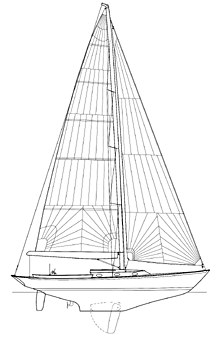Friendship 40
Family cruiserr
Here's another design with aesthetics taken from another era. This design is by Ted Fontaine and is the smallest design I have seen from Ted. Ted's got "the eye." This is a handsome design and I like just about everything. It's not going to be a rocket in any conditions but that was not the idea. (It won't be a pig either.) The idea was to provide an elegant daysailer or weekend cruiser that could be handled with ease. That said, there is nothing about this boat that would prevent you from sailing it anywhere you wanted.
Spoon bow, elevated counter, heart shaped transom and beautiful springy sheer all combine to give this design a vintage look. It's a heavy boat with a D/L of 388. This displacement is reflected in the generous fore and aft rocker to the hull. This is a boat that will hit its hull speed at about 7 knots and sit there. Any attempt to drive this boat much above 8 knots will result in the hull just digging a big hole in the water. That's okay. It's just the price you pay for having overhangs and copious displacement. Draft is a scant 3 feet, 11 inches with the board retracted and 10 feet, 3 inches with the board down. Beam is wide with an L/B of 3.18. This boat will be stiff. If I was going to nitpick I'd mention that it's hard to carry off these aesthetics while using the freeboard required to get today's required headroom and accommodation volume. The old boats had low freeboard and this boat does not. Ted has carefully not drawn the DWL on the profile so as to confuse our eye into thinking the freeboard is low. I'm not fooled.
The rig is where the innovation is. Ted has devised what he calls the Sail Stick. This is a device that controls the mainsail with a joystick. Push the stick up and the mainsail goes up. Push it down and the sail is retracted into the furling boom. Push the stick to one side and the mainsheet is eased. Push it the other way and the mainsheet is pulled in. It reminds me a bit of when I bought my first Peugeot. It took me a while to get used to the "joysticks" on the wheel. I would approach a corner, wash my windshield, engage the cruise control, disengage the cruise control, turn on the windshield wipers, turn off the windshield wipers, then turn on the turn signal. Well maybe it's not that bad and I'm sure there are some of you who want the physically demanding aspects removed from sailing. I'm not there yet. I'd go for oversized winches before I'd go the joystick route. This is not a big boat. I don't think it needs so much power assistance. At least I don't think that today. Talk to me again in 15 years or on a day when my back is acting up.
The jib is self-tacking and on a hydraulic furling unit. These functions are again controlled by a joystick. Of course I can remember laughing at powered sheet winches years ago in the pre-ibuprofen days. The SA/D of this design is 17.24. The three spreaders are swept and the headstay does not go to the masthead. On a boat of this weight I might prefer to see less sweep to the spreaders so I don't impale the mainsail so quickly when it is eased.
The cockpit is huge. This is where you will live on this boat. You can dine in the cockpit at the big folding table. You can entertain those sleepy friends very comfortably in this cockpit. They can even fall asleep on those long seats. A dodger would be easy to mount for rainy weather sailing. Imagine the volume below this cockpit for stowage. This is really the cockpit of a 50-footer connected to the interior of a 30-footer. Given the ratio of time spent in the cockpit to time spent below I would agree with this allocation of space.
This is an appealing boat. It's great looking and unique in its approach to comfort. It's giving me visions of luxurious, well-fed, singlehanded cruising. Where would I put my Martin?

Comments